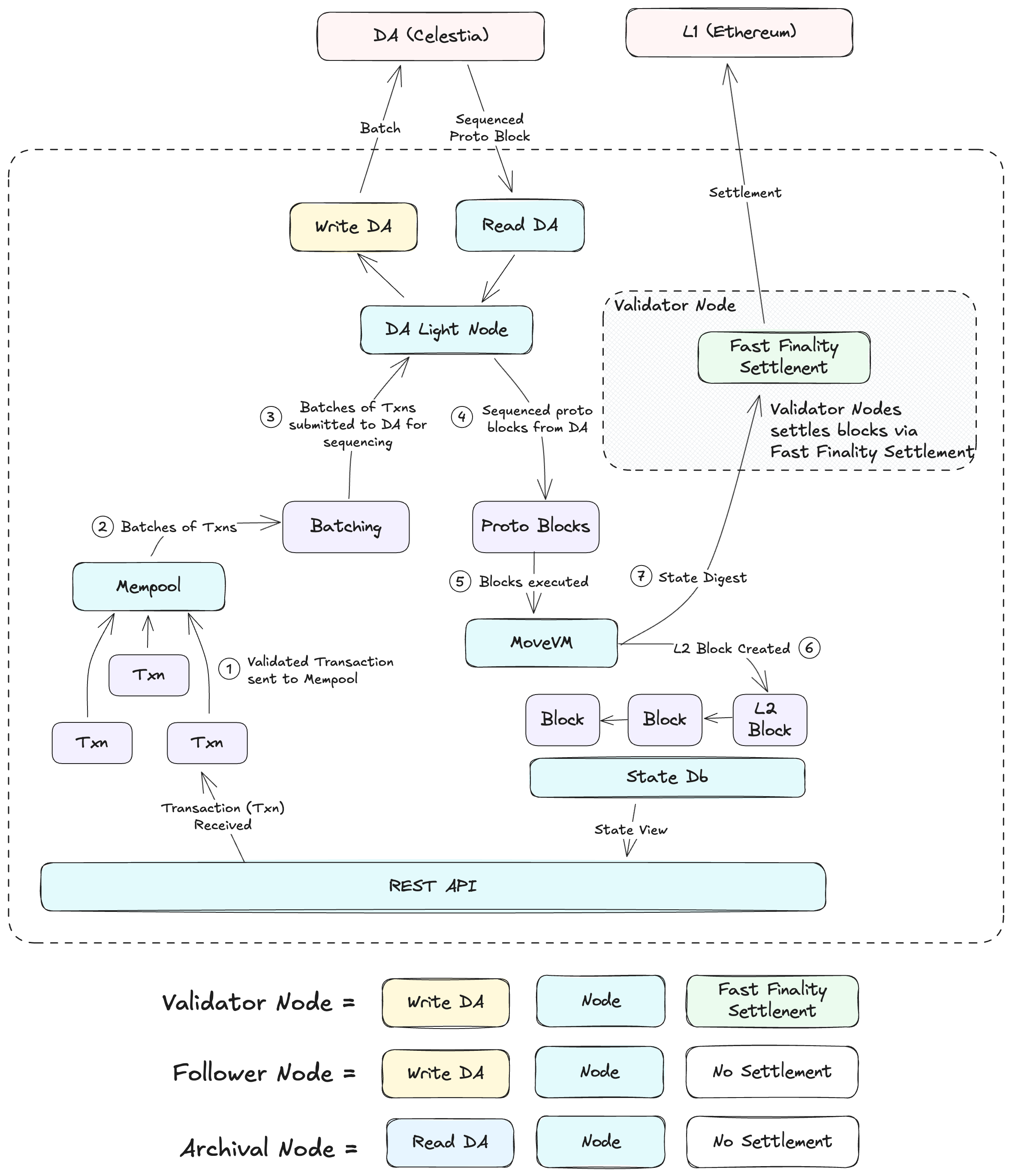Movement Architecture Overview
Movement Labs is building a high-performance, scalable blockchain infrastructure leveraging the Move programming language and modular architecture. The Movement Network consists of multiple node types, a robust data availability layer, a shared sequencing mechanism, and a fast finality settlement module to ensure efficient transaction processing and security.
Node-Level Architecture
The Movement Network comprises various node types, each serving a specific role within the ecosystem.
Full Node
A full node provides the core functionality of the Movement network by:
- Accepting transactions into a local mempool.
- Batching transactions and forwarding them to the DA Light Node.
- Executing blocks received from the Data Availability (DA) layer (called protoBlocks).
- Offering API access to both optimistic and finalized states.
- Enabling deterministic state transitions, leading to the creation of L2 blocks.
A full node can be configured in different modes:
- Validator Node: Settles blocks via the Fast Finality Settlement (FFS) module.
- Follower Node: Supports RPC services without requiring settlement permissions.
- Archival Node: Maintains historical blockchain data but does not write new blocks.
Validator Node
Validator nodes play a critical role in ensuring transaction finality by:
- Attesting to the correctness of state transitions.
- Utilizing cryptographic mechanisms to verify transactions.
- Initially depending on a Core-Validator, but transitioning towards a decentralized validation model.
Follower Node
A Follower Node enhances network scalability by:
- Providing increased transaction ingestion capacity.
- Supporting query operations on blockchain state.
- Operating independently from validator permissions, making it ideal for RPC providers.
DA Light Node
A Data Availability (DA) Light Node is a standalone service handling:
- Write operations: Forwarding signed transaction batches to the DA layer.
- Read operations: Retrieving and verifying ordered protoBlocks.
- Verification parameter updates (future feature).
Archival Node
An Archival Node is a read-only node that:
- Synchronizes with the DA network.
- Provides historical blockchain data.
- Does not participate in transaction settlement or DA writing.
High-Level Architecture

The Movement Network follows a modular blockchain design consisting of multiple interconnected components.
Data Availability (DA) Layer
The Celestia blockchain serves as the primary Data Availability (DA) layer, responsible for:
- Storing transaction data in ordered protoBlocks.
- Ensuring decentralized access to transaction history.
- Preventing data censorship.
Transaction Sequencing
To protect the DA layer from spam:
- Only authorized full nodes can sequence transaction batches.
- These nodes organize user transactions into ordered batches.
- Sequenced batches are sent to the DA layer via the DA Light Node.
Transaction Execution
- Full nodes receive protoBlocks from the DA layer.
- The transactions are executed, and an updated state root is generated.
- L2 blocks are created, containing execution results and cryptographic proofs.
Settlement Layer
The Fast Finality Settlement (FFS) Module ensures quick and secure transaction finalization by:
- Using validator attestations to confirm state transitions.
- Checking against Layer 1 (L1) postconfirmed state roots for increased security.
- Transitioning from a Core-Validator model to decentralized validation.
- Requiring a supermajority of validator attestations to update state roots on L1.
Fees & Economic Model
Transaction fees are structured as:
fee = data_availability_fee + sequencing_fee + execution_fee + settlement_feeThese fees fund network services, ensuring decentralized economic sustainability.
Interoperability & Security
Movement enhances security and interoperability through:
- Shared Decentralized Sequencer: Ensures fair and censorship-resistant transaction ordering across multiple chains.
- Multi-Asset Staking: Allows staking of both native and non-native assets to enhance economic security.
- Fast Finality Settlement (FFS): Reduces transaction finality time compared to traditional rollups.
- Ethereum Integration: Move-based execution coexists with EVM bytecode, enabling compatibility with Ethereum-based applications.
Development Ecosystem
Developers on Movement Labs benefit from:
- Move Frameworks: A robust development environment for Move-based smart contracts.
- Indexers: A GraphQL-based API for querying blockchain data efficiently.
- Wallet Standards: Support for Aptos Wallets, ensuring compatibility across multiple dApps.
- Explorers: Block explorers to visualize transaction history and chain states.
By integrating Move-based execution, modular settlement, and decentralized sequencing, Movement Labs provides a fast, efficient, and developer-friendly environment for building on Web3.